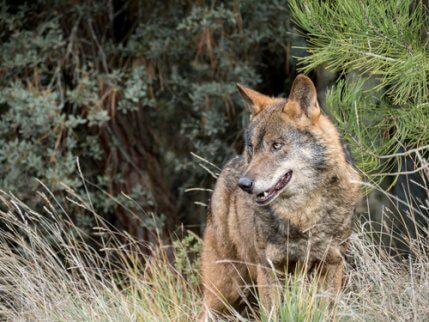All About the Iberian Wolf


Written and verified by the vet Eugenio Fernández Suárez
The Iberian Wolf (Canis lupus signatus) is probably the most representative animal out of all those that live on the Iberian peninsula. It’s a particularly adept hunter because it tends to hunt in packs.
What’s the Iberian Wolf like?
The Iberian Wolf is smaller than many other subspecies of wolf. It doesn’t weigh more than 100 lb whereas the American or Russian wolves can reach 180 lb.
The Iberian wolf also has a distinctive appearance, with dark patches on their tail, back, and legs. These markings are what give them their Latin name and they’re the only subspecies that have them.
What’s their behavior like?
The Iberian Wolf lives in a pack, like many other wolf species. But despite what you might think, the existence of an ‘alpha’ wolf is a myth, and the same is true for this subspecies.
Normally, Iberian Wolf packs are family groups, with a male and female adult accompanied by their cubs, which, in turn, can consist of multiple litters. In fact, wolves have quite a complex emotional side, despite their reputation for being ruthless hunters.

Where does the Iberian Wolf live?
Historically, the Iberian Wolf lives right across the Iberian peninsula. However, in the last 50 years, they have been hunted to the brink of extinction.
Thanks to naturalists like Félix Rodríguez de la Fuente, awareness has increased and this wolf isn’t protected in many parts of Spain.
Currently, most of the wolf population in Western Europe is found in the Sierra de la Culebra, a mountain range in Castile and León, in Spain.
There are also many Iberian Wolf populations in León, Asturias, and Galicia, and they’ve even begun to be seen in Ávila, Madrid, and the Basque Country. The population that lives in the Sierra Morena is considered to be practically extinct since it is completely isolated.
What’s the current conservation status of the Iberian Wolf?
This is a difficult question to answer because it depends on which side of the River Douro we look at. To the north of the river, this wolf can still be freely hunted, whilst to the south, it’s a protected species.
It’s unknown exactly how many Iberian wolves there currently are on the peninsula. But the latest figures from the 1980s point to a population of just over 2,000. It’s currently believed that there are around 3,000 today.

The truth is that, whilst the species as a whole doesn’t appear to be at great risk of extinction presently, there are areas where they’re dying out. Ideally, we should carry out an independent reliable survey to demonstrate exactly how many there currently are.
The conflict with livestock farming
The main reason that the Iberian Wolf is under threat is that it poses a threat to livestock, just like the brown bear. Unfortunately, the majority of livestock animals in the high mountains still haven’t adapted to the presence of this wolf species.
Some farmers have tried preventative measures, like the use of fences or mastiffs as guard dogs. But whilst these provide a certain level of protection, this increases costs, which in turn threatens the farming industry itself. And this type of free-range farming is the type that most respects animals and the ecosystem.
One way to resolve this would be for more conscientious consumers to choose ecological, sustainable products from areas where wolves live. This would help farmers to protect their livestock without threatening the existence of the wolves.
These days, it’s a highly contentious situation. Whilst many want to see this wolf completely protected, this would pose a threat to livestock animals. Others want to see this wolf freely hunted, but this could lead to it completely disappearing from the peninsula.
This text is provided for informational purposes only and does not replace consultation with a professional. If in doubt, consult your specialist.